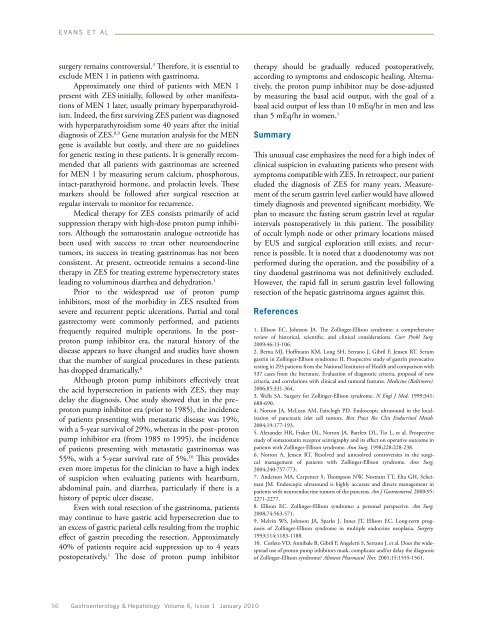Primary Hepatic Gastrinoma: An Unusual Case of Zollinger-Ellison ...
Primary Hepatic Gastrinoma: An Unusual Case of Zollinger-Ellison ...
Primary Hepatic Gastrinoma: An Unusual Case of Zollinger-Ellison ...
Create successful ePaper yourself
Turn your PDF publications into a flip-book with our unique Google optimized e-Paper software.
E V A N S e t a lsurgery remains controversial. 3 Therefore, it is essential toexclude MEN 1 in patients with gastrinoma.Approximately one third <strong>of</strong> patients with MEN 1present with ZES initially, followed by other manifestations<strong>of</strong> MEN 1 later, usually primary hyperparathyroidism.Indeed, the first surviving ZES patient was diagnosedwith hyperparathyroidism some 40 years after the initialdiagnosis <strong>of</strong> ZES. 8,9 Gene mutation analysis for the MENgene is available but costly, and there are no guidelinesfor genetic testing in these patients. It is generally recommendedthat all patients with gastrinomas are screenedfor MEN 1 by measuring serum calcium, phosphorous,intact-parathyroid hormone, and prolactin levels. Thesemarkers should be followed after surgical resection atregular intervals to monitor for recurrence.Medical therapy for ZES consists primarily <strong>of</strong> acidsuppression therapy with high-dose proton pump inhibitors.Although the somatostatin analogue octreotide hasbeen used with success to treat other neuroendocrinetumors, its success in treating gastrinomas has not beenconsistent. At present, octreotide remains a second-linetherapy in ZES for treating extreme hypersecretory statesleading to voluminous diarrhea and dehydration. 1Prior to the widespread use <strong>of</strong> proton pumpinhibitors, most <strong>of</strong> the morbidity in ZES resulted fromsevere and recurrent peptic ulcerations. Partial and totalgastrectomy were commonly performed, and patientsfrequently required multiple operations. In the post−proton pump inhibitor era, the natural history <strong>of</strong> thedisease appears to have changed and studies have shownthat the number <strong>of</strong> surgical procedures in these patientshas dropped dramatically. 8Although proton pump inhibitors effectively treatthe acid hypersecretion in patients with ZES, they maydelay the diagnosis. One study showed that in the pre−proton pump inhibitor era (prior to 1985), the incidence<strong>of</strong> patients presenting with metastatic disease was 19%,with a 5-year survival <strong>of</strong> 29%, whereas in the post−protonpump inhibitor era (from 1985 to 1995), the incidence<strong>of</strong> patients presenting with metastatic gastrinomas was55%, with a 5-year survival rate <strong>of</strong> 5%. 10 This provideseven more impetus for the clinician to have a high index<strong>of</strong> suspicion when evaluating patients with heartburn,abdominal pain, and diarrhea, particularly if there is ahistory <strong>of</strong> peptic ulcer disease.Even with total resection <strong>of</strong> the gastrinoma, patientsmay continue to have gastric acid hypersecretion due toan excess <strong>of</strong> gastric parietal cells resulting from the trophiceffect <strong>of</strong> gastrin preceding the resection. Approximately40% <strong>of</strong> patients require acid suppression up to 4 yearspostoperatively. 1 The dose <strong>of</strong> proton pump inhibitortherapy should be gradually reduced postoperatively,according to symptoms and endoscopic healing. Alternatively,the proton pump inhibitor may be dose-adjustedby measuring the basal acid output, with the goal <strong>of</strong> abasal acid output <strong>of</strong> less than 10 mEq/hr in men and lessthan 5 mEq/hr in women. 1SummaryThis unusual case emphasizes the need for a high index <strong>of</strong>clinical suspicion in evaluating patients who present withsymptoms compatible with ZES. In retrospect, our patienteluded the diagnosis <strong>of</strong> ZES for many years. Measurement<strong>of</strong> the serum gastrin level earlier would have allowedtimely diagnosis and prevented significant morbidity. Weplan to measure the fasting serum gastrin level at regularintervals postoperatively in this patient. The possibility<strong>of</strong> occult lymph node or other primary locations missedby EUS and surgical exploration still exists, and recurrenceis possible. It is noted that a duodenotomy was notperformed during the operation, and the possibility <strong>of</strong> atiny duodenal gastrinoma was not definitively excluded.However, the rapid fall in serum gastrin level followingresection <strong>of</strong> the hepatic gastrinoma argues against this.References1. <strong>Ellison</strong> EC, Johnson JA. The <strong>Zollinger</strong>-<strong>Ellison</strong> syndrome: a comprehensivereview <strong>of</strong> historical, scientific, and clinical considerations. Curr Probl Surg.2009;46:13-106.2. Berna MJ, H<strong>of</strong>fmann KM, Long SH, Serrano J, Gibril F, Jensen RT. Serumgastrin in <strong>Zollinger</strong>-<strong>Ellison</strong> syndrome: II. Prospective study <strong>of</strong> gastrin provocativetesting in 293 patients from the National Institutes <strong>of</strong> Health and comparison with537 cases from the literature. Evaluation <strong>of</strong> diagnostic criteria, proposal <strong>of</strong> newcriteria, and correlations with clinical and tumoral features. Medicine (Baltimore).2006;85:331-364.3. Wells SA. Surgery for <strong>Zollinger</strong>-<strong>Ellison</strong> syndrome. N Engl J Med. 1999;341:688-690.4. Norton JA, McLean AM, Fairclogh PD. Endoscopic ultrasound in the localization<strong>of</strong> pancreatic islet cell tumors. Best Pract Res Clin Endocrinol Metab.2004;19:177-193.5. Alexander HR, Fraker DL, Norton JA, Bartlett DL, Tio L, et al. Prospectivestudy <strong>of</strong> somatostatin receptor scintigraphy and its effect on operative outcome inpatients with <strong>Zollinger</strong>-<strong>Ellison</strong> syndrome. <strong>An</strong>n Surg. 1998;228:228-238.6. Norton A, Jensen RT. Resolved and unresolved controversies in the surgicalmanagement <strong>of</strong> patients with <strong>Zollinger</strong>-<strong>Ellison</strong> syndrome. <strong>An</strong>n Surg.2004;240:757-773.7. <strong>An</strong>derson MA, Carpenter S, Thompson NW, Nostrant TT, Elta GH, ScheimanJM. Endoscopic ultrasound is highly accurate and directs management inpatients with neuroendocrine tumors <strong>of</strong> the pancreas. Am J Gastroenterol. 2000;95:2271-2277.8. <strong>Ellison</strong> EC. <strong>Zollinger</strong>-<strong>Ellison</strong> syndrome: a personal perspective. Am Surg.2008;74:563-571.9. Melvin WS, Johnson JA, Sparks J, Innes JT, <strong>Ellison</strong> EC. Long-term prognosis<strong>of</strong> <strong>Zollinger</strong>-<strong>Ellison</strong> syndrome in multiple endocrine neoplasia. Surgery.1993;114:1183-1188.10. Corleto VD, <strong>An</strong>nibale B, Gibril F, <strong>An</strong>geletti S, Serrano J, et al. Does the widespreaduse <strong>of</strong> proton pump inhibitors mask, complicate and/or delay the diagnosis<strong>of</strong> <strong>Zollinger</strong>-<strong>Ellison</strong> syndrome? Aliment Pharmacol Ther. 2001;15:1555-1561.56 Gastroenterology & Hepatology Volume 6, Issue 1 January 2010


